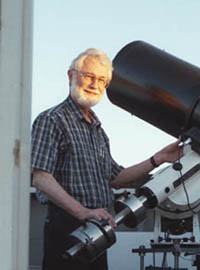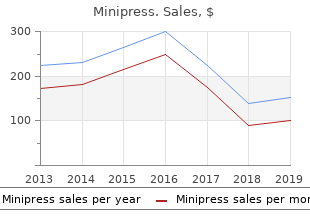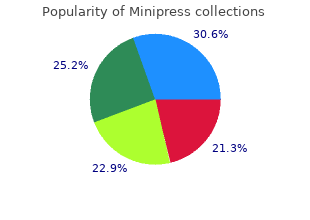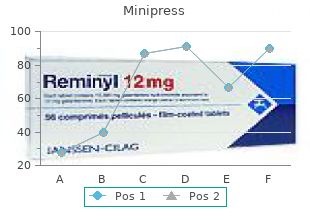Minipress
"Order 1mg minipress visa, treatment 7th feb bournemouth."
By: Bertram G. Katzung MD, PhD
- Professor Emeritus, Department of Cellular & Molecular Pharmacology, University of California, San Francisco

http://cmp.ucsf.edu/faculty/bertram-katzung
Echinococcus granulosus: a seroepidemiological survey in Visualization of hydatid elements: comparison of several northern Israel using an enzyme-linked immunosorbent techniques minipress 1 mg with amex. Ultrasonographic appearance of an tibility to order minipress 2 mg on-line Echinococcus multilocularis infection and cyto Echinococcus ovarian cyst cheap minipress 2mg line. Immunodiagnosis of infections registry: human alveolar echinococcosis order minipress 2 mg free shipping, Europe, 1982� with cestodes, p. Analysis of specific immunoglobulin G subclass antibodies Gastroenterology 109:596�600. Frank intra Serological differentiation between cystic and alveolar biliary rupture of hydatid cyst: diagnosis and treatment. Domestic pets as risk factors for fractions of Echinococcus granulosus cyst fluid (antigen B) alveolar hydatid disease in Austria. Intrabiliary rupture of hepatic ecology of Echinococcus in wild-life in Australia and hydatid cysts: diagnosis by use of magnetic resonance Africa. Molecular genetic characterization of the antibodies in serum of patients with hydatidosis recog Fennoscandian cervid strain, a new genotypic group (G10) nized by immunoblotting. Vaccination trials in Australia and Argentina for alveolar echinococcosis in humans. Hydatid cyst of the liver communicating with the granulosus infection in the central Peruvian Andes. Cytologic diagnosis of complicated ly infected with Echinococcus granulosus by a monoclonal pulmonary unilocular cystic hydatidosis�a study of 131 antibody-based enzyme-linked immunosorbent assay. Short report: molecular Echinococcosis in Humans and Animals: a Public Health genetic characterization of an unusually severe case of hydatid Problem of Global Concern. World Organisation for disease in Alaska caused by the cervid strain of Echinococcus Animal Health, Paris, France. Intraaortic growth of hydatid cysts causing occlu multilocularis metacestodes in sera of patients with alveo sion of the aorta and of both iliac arteries: case report. Differential immunodiagnosis between cystic hyda assay as a new diagnostic test for human hydatid disease. The epidemiol Spontaneous systemic anaphylaxis as an unusual presenta ogy of echinococcosis caused by Echinococcus oligarthrus tion of hydatid cyst: report of two cases. Immunological radiosurgery and albendazole for cerebral alveolar hydatid approaches for transmission and epidemiological stud disease. Treatment options for ultrasound as a mass screening technique for the detection hepatic cystic echinococcosis. A review of human sparganosis in in Bulgaria: a comparative epidemiological analysis. Secondary Simultaneous alveolar and cystic echinococcosis of the multiple intracranial hydatid cysts caused by intracerebral liver. Molecular characterization of pancreatic head hydatid cyst with obstructive jaundice. Water vole (Arvicola terrestris Scherman) density operative biliary strictures secondary to hepatic hydatid as risk factor for human alveolar echinococcosis. The possible role of age of the human host in deter Effect of mebendazole on human cystic echinococcosis: the mining the localization of hydatid cysts. Concepts bars for dogs in the prevention and control of cystic echino in immunology and diagnosis of hydatid disease. The adult worms vary in size from the barely visible (Heterophyes heterophyes) to the very large (Fasciolopsis buski). To complete the life cycle, specific species of intermediate hosts must be available for trema tode development. All of the intestinal trematodes require a freshwater snail to serve as an intermediate host. These infections are food borne and are emerg ing as a major public health problem, with more than 50 million people being infected (Algorithm 15. Intestinal trematode infections can be found in Southeast Asia, the Far East, the Middle East, and North Africa. Eggs deposited by the adult worms are passed to the outside in the feces (Figure 15. All intestinal trematode eggs have an operculum, or �lid,� from which the miracidium larva can escape. Eggs hatch in freshwater, and these larvae must find their way into the snail (intermediate host) through penetra tion of the snail tissues; in some cases, the snail ingests the eggs before they hatch. A series of developmental stages occur within the snail, eventually producing cercariae, which are released from the snail. These cercariae then encyst on aquatic plant material or encyst in the tissues of freshwater mollusks or fish and become metacercariae. When the plants or mollusks are ingested raw, the metacercariae then infect the human host, where they excyst in the small intestine and develop into mature adult trematodes within the intestinal tract. Adult worms vary in shape and size and can be distinguished from one another (Table 15. The adult worms are hermaphroditic, con taining both male and female reproductive systems. Fasciolopsis buski Fasciolopsiasis was first noted by Busk in 1843, when worms were detected in the duodenum of a deceased East Indian sailor (2).

However discount minipress 2 mg, only 3 of 21 children with epileptiform activity developed a seizure disorder buy minipress 1 mg on line. For example generic 2 mg minipress, a �comb-like� central rhythm has been observed in neonates with maple syrup-urine disease 2mg minipress with visa, and bifrontal slow spike-and-wave discharges have been reported in the ring 20 chromosome syndrome. Etiology is also included in epilepsy clas sification, whether symptomatic, cryptogenic, or idiopathic, and either generalized or focal. Epileptic syndromes are divided into benign or malignant, depending on the expected out come. In general, the �idiopathic� epilepsies are analogous to the benign epileptic syndromes, and the �symptomatic� epilepsies are analogous to the malignant epileptic syndromes. Malignant syndromes generally are resistant to treatment and have a poor prognosis. However, not every �benign� epileptic syndrome is associated with a normal outcome, and not every �malignant� epileptic syndrome has a poor outcome. For example, a small number of children with benign familial neonatal seizures will have developmental problems and persistent seizures, some children with absence epilepsy can have learning difficulties, and photosensitive epilepsy can occasionally be severe. Specific seizure semiology can be identified from temporal, frontal, parietal, and occipital regions. Clinical manifestations by location are similar in both adult and child hood epilepsy. Most specific epileptic syndromes begin in childhood and may continue into adulthood. We shall start with the benign epileptic syndromes and then the malignant syndromes. Alvarez and Lombroso reported hypnagogic paroxysmal spike wave activity (minimal epileptiform features, sharp waves embedded into hyperventilation, or hypnagogic hypersynchrony) occurring with a higher inci dence in children with febrile seizures. This is similar to epileptiform activity admixed into ver tex waves and sleep spindles, called dyshormia by Niedermeyer (Fig. These features may indicate a lower seizure threshold and explains why they occur in both the normal population and in those with epilepsy. Benign Myoclonic Epilepsy in Infancy this disorder is characterized by brief bursts of generalized myoclonus that begin in other wise normal children during the first 2 yr of life. Childhood Absence Epilepsy the peak age of onset of childhood absence epilepsy is from 6 to 7 yr. The seizures con sist of an abrupt cessation of ongoing activity, with a change of facial expression and a blank gaze. The duration is short, rarely lasting longer than 30 s, there is no preceding aura or sub sequent postictal depression, and there may be frequent automatisms. Typical absence seizures are classified as simple or complex; a simple absence has a sudden onset without motor activity; complex absences have associated motor activity or autonomic activ ity. Atypical absence seizures may have more pronounced tone changes, a longer duration, and are typically asso ciated with other seizure types and mental retardation. Automatisms may be perseverative or de novo, and autonomic abnormalities may consist of pupillary dilatation, pallor, flushing, salivation, or incontinence. Arrest of activity, staring, and oral and manual automatisms were observed in both groups. Juvenile Absence Epilepsy the onset is around puberty, but the seizures may be less frequent than in the childhood absence syndrome. There may also be electrographic discharges that are more prolonged, with less altered awareness. The myoclonic seizures are usually mild to moderate in intensity, may involve the entire extremity, rather than isolated muscles, and generally are bilateral. These occur after awak ening and are aggravated by fatigue, sleep deprivation, or alcohol. Ten to 16-Hz rapid spikes with slow waves occur with myoclonic seizures, photosensitivity is common, and abnormalities may occur in sleep. Note the spike component embedded with a vertex wave (A) and within spindles (B) during sleep. Twelve-year-old girl with seizures denoted by staring and a family history of seizure. Benign Focal Epilepsy of Childhood this disorder is also called benign childhood partial seizures. The centro�temporal location is the most common, followed by the occipital location. According to Lerman, the seizure frequency is low, 13% may have just one seizure, 66% have infrequent seizures, and 21% have frequent seizures. The typical seizure characteristics consist of oral�buccal�lingual paresthe sias, speech arrest, preservation of consciousness, sialorrhea, and tonic or clonic facial move ments. The seizures are nocturnal in 50% of patients, occur in both the waking and sleep states in 15% of patients, and the waking state in only 10 to 20% of patients. The prognosis is excellent, seizures are usually well-controlled, and the seizure fre quency, recurrence, and duration are similar in treated and untreated children. Lombroso referred to these as �sylvian� seizures, given the location of the discharges near the Sylvian fissure. However, when additional scalp electrodes are placed, maximum negativity was in the cen tral region, either in a �high� (C3, C4) or �low� (C5, C6) location.

Combined with the deleterious alterations in metabolic profle (see above) this may increase cardiovascular risk discount minipress 2 mg line. Thrombotic events include sagittal sinus order 1 mg minipress overnight delivery, cerebrovascular thrombosis and myocardial infarction quality minipress 2mg. Lactation Androgens are contraindicated as it is not known whether they are excreted in human milk buy minipress 1mg. Children the use of synthetic androgens is not recommended in pre-pubertal children. Risks include precocious sexual development in boys, virilization in girls and premature closure of the epiphyses in both sexes. If used in children, growth should be carefully monitored with radiography if indicated to assess bone age. Symptoms that may suggest a liver problem include persistent nausea and vomiting, abdominal pain, or the development of jaundice. Benefts and risks of danazol in hereditary angioedema: a long-term survey of 118 patients. Androgen receptor antagonists include drugs, such as the steroidal antiandrogens, spironolactone and cyproterone acetate, which also have direct inhibitory effects on androgen synthesis, and the non-steroidal or �pure� antiandrogens, futamide and bicalutamide. Its mechanism of action is inhibiting androgen uptake and inhibiting nuclear binding of androgen in target tissues. These drugs were developed for the treatment of prostate cancer but at lower doses have been found to be effective in the treatment of females with hirsutism. Spironolactone is an aldosterone antagonist and acts as a potassium sparing diuretic. It inhibits the action of aldosterone on the distal renal tubule, increasing sodium and water excretion and reducing potassium excretion. Spironolactone is also a potent antagonist of the androgen receptor as well as an inhibitor of androgen production, hence its use to treat androgen related skin disease in females, namely hirsutism, androgenic alopecia and acne. It also counteracts the oestrogen stimulated activity of the renin� angiotensin�aldosterone system, and has also been shown to possess mild antiandrogen activity. It is used in combination with an oestrogen for hormonal oral contraception and hormone replacement therapy. Cyproterone acetate is a synthetic derivative of 17-hydroxyprogesterone, and acts primarily as an androgen receptor antagonist. It also has weak progesterone agonist and glucocorticoid actions and inhibits androgen synthesis. Cyproterone acetate was the frst antiandrogen in clinical use and was introduced 1964. Males with a genetic defciency of type 2 5a-reductase do not suffer from male pattern hair loss. The enzyme 5a-reductase exists as two isoenzymes; type 1 is the dominant form in non-genital skin including the scalp and the sebaceous glands, while type 2 is the dominant form in genital skin, the prostate and hair follicles of the scalp, where miniaturization takes place. Finasteride selectively inhibits the type 2 isoenzyme whereas dutasteride inhibits both type 1 and type 2 5a-reductase. Other drugs with antiandrogenic effects include the corticosteroids, prednisolone and dexamethasone, which inhibit adrenal androgen secretion, particularly when given as a nocturnal dose (see Corticosteroids). Metformin, an insulin sensitizing agent, has been suggested to have direct antiandrogen actions on ovarian steroid synthesis as well as improving insulin sensitivity and reducing insulin levels, which leads to a reduction in circulating free androgens. The combined preparation also functions as a hormonal contraceptive, but is not licensed specifcally for this purpose. Other licensed uses are: � Finasteride, dutasteride: benign prostatic hyperplasia. A combined preparation, co-cyprindiol, containing cyproterone acetate 2 mg and ethinyloestradiol 35 �g is available as sugar coated tablets (Dianette). A higher daily dose (5 mg) is used for the treatment of benign prostatic hyperplasia but does not increase effcacy in hair loss. A placebo-controlled study reported that this dose had superior effects on hair growth and hair count to fnasteride. Capsules should be swallowed whole and not chewed or opened, as contact with the contents may cause irritation of the oropharyngeal mucosa. The onset of effect of these agents in male androgenic alopecia is slow and it usually takes 6 months to stabilize hair loss. Treatment arrests the progression of disease, but regrowth is partial at best and continued treatment is required to sustain beneft. If treatment is stopped, the benefcial effects begin to reverse by 6 months and return to baseline by 9�12 months. At the recommended dose, fnasteride has been shown to improve the anagen (growing phase) follicle count in males with vertex baldness while those given placebo lost anagen hair. The majority of males continue to beneft from long-term 31 Antiandrogens treatment (up to 10 years). Spironolactone: a low starting dose of 25�50 mg daily is recommended to reduce side-effects, followed by dose increases up to 200 mg daily as maintenance therapy. Cyproterone acetate: for the treatment of hirsutism and female pattern hair loss, 50 mg daily is usually suffcient, although up to 100 mg/d can be used. Co-cyprindol is taken once daily for 21 days, followed by a 7-day tablet free interval when a withdrawal bleed should occur.

Autoimmune diseases are characterized by the inappropriate or excessive immune response against autoantigens buy 1mg minipress overnight delivery, leading to minipress 2mg line chronic inflammation purchase minipress 2mg without prescription, tissue destruction generic minipress 2 mg line, and/or dysfunction. The main measurable feature of an autoimmune disease is the production and long-lasting expression of disease-specific autoantibodies and/or autoreactive T cells. How ever, the classification of autoimmune disease demands additional evidence, which may be direct, indirect, or circumstantial (Rose, 1996). Direct evidence of the autoimmune nature of an auto antibody and/or cell-mediated disease includes (i) dysfunction producing circulating autoantibodies (target cell damage, receptor stimulation or inhibition, interaction with an enzyme or hormone), (ii) autoantibodies localized to the site of the lesion, (iii) immune complexes containing autoantibodies localized to the site of the lesion, (iv) reproduction of disease by passive transfer of autoanti bodies (maternal�fetal transfer producing congenital autoimmune disease, animal models), (v) proliferation of T cells in vitro in response to self-antigen or autoantigen, (vi) induction of disease by xenotransplantation of human target tissue plus injection with sensitized T lymphocytes to immunodeficient mice, and (vii) in vitro cytotoxicity of T cells with cells of the target organ. Much indirect evidence is shown by different kinds of animal models, such as experimental immunization, development of spontaneous auto immunity, and animal models produced by manipulation of the immune system. The so-called classical autoimmune disease fulfils at least three criteria of direct evidence as well as almost all of those of the indirect and circumstantial evidence. Generally, autoimmune diseases are perceived to be rare; however, when all autoimmune diseases are combined, the estimated prevalence of 3�5% is not rare, which underlines their importance in the public health sector. Because of problems in designing and standardizing epidemiological studies and because of the fact that only limited data are available, this prevalence may be under estimated (Jacobson et al. There is epidemiological evidence of increasing prevalence of some autoimmune diseases. According to the clinical manifestation, autoimmune diseases may be classified as systemic. However, this clinically useful classification does not correspond to the underlying pathogenetic mechanisms. Despite progress in the research of autoimmune processes, the etiologies and pathological mechanisms involved in the development of autoimmune disease are incom pletely understood. A multifactorial genesis, including immuno logical, genetic, endocrine, and environmental factors, is suggested by evidence from both human and animal studies (Shoenfeld & Isenberg, 1990). Different mechanisms, which are not mutually exclusive, may be involved in the induction and progression of pathological autoimmunity; these include genetic or acquired defects in immune tolerance or immunoregulatory pathways, molecular mimicry to viral or bacterial proteins, an impaired clearance of apoptotic cell material, the generation of autoimmunity to cryptic or modified self, adjuvant-like activity, and susceptibility of target organ(s) for the autoimmune attack (Oldstone, 1987; Wick et al. Environmental factors operating in a genet ically susceptible host may directly initiate, facilitate, or exacerbate the pathological immune process, induce mutations in genes coding for immunoregulatory factors, or modify immune tolerance or regulatory and immune effector pathways. The search for such factors and the elucidation of their action are therefore of great importance for better understanding the pathogenesis of autoimmune disease as well as for improving the prophylaxis and therapy of these diseases. In evolutionary terms, the immune response of vertebrate animals represents a consolidation of two systems. The more ancient innate immune system response is shared, to some degree, by all multi cellular animals. It includes a number of physical, chemical, and biological barriers that combine to prevent or control microbial invasion; together, they stand guard on an immediate and constant basis. The second, more recently evolved, system provides vertebrates with the acquired or adaptive immune response. Although it requires more time to mount, in terms of several days, adaptive immunity is aimed at a particular pathogen. Since the variety of pathogens is increasing and constantly changing, the adaptive immune response needs an extensive capacity for recognition and so has evolved a unique system of gene recombination. At the same time, the adaptive response reconfigures and reuses many of the components of the innate immune response to produce its effects. Because the adaptive immune response requires the generation of such broad diversity in recognition capabilities, it also recognizes molecules found in the body of the host itself. In an effort to avoid this harm, the body carefully shapes, regulates, and controls the adaptive immune response. The fundamental concepts of how immunity develops form the basis for an understanding of how environmental agents can interact with the immune system to trigger autoimmune disease. During the Middle Ages, it took on a derived meaning of free from disease, and the term now refers to the many strategies employed by the body to avoid or limit infectious (and perhaps malignant) disease. Initial defence is pro vided by the natural or innate immune response, which provides immediate, non-pathogen-specific resistance to disease. Innate immune defences are inherited and, therefore, generally present from birth. They include external chemical and physical barriers provided by the skin and mucous membranes, as well as various internal defence mechanisms, such as inflammation and phago cytosis. The skin provides a formidable physical barrier that very few, if any, microorganisms can penetrate. If, however, the skin is damaged, pathogens can invade, penetrating other parts of the body. The mucous membranes represent much less of a physical barrier, but can call upon a number of defensive devices. These include mucus itself, which entraps many microorganisms, the hair-like cilia of the respiratory passages, which propel inhaled organisms towards locations where they can be expelled by coughing or sneezing, and specific antimicrobial agents, such as the enzyme lysozyme in saliva and tears. The flow of urine retards microbial colonization of the urinary system, and the normal microbial population of the large intestine retards the overgrowth of pathogenic organisms. When pathogens penetrate the barriers of skin and mucous membranes, they encounter internal inborn defences. Inflammation is a stereotypic defensive response of the body to most forms of tissue injury, whether chemical, physical, or infectious. The cardinal signs of redness, pain, heat, and swelling serve to localize the infection and recruit cells of the innate immune response. They include the major circulating phagocytic cells, neutrophils, which leave the blood and migrate to inflamed areas. The process involves, first, adherence of the cells to the vascular endothelium of vessels near the damaged tissue site, followed by passage through the endothelial lining and chemotactic attraction to the site of damage. Tissue phagocytes, macrophages, also migrate to the site of 10 Introduction to the Immune System inflammation. A group of normally inactive proteins in the blood plasma also becomes activated by inflam matory reactions.
Buy minipress 2 mg with mastercard. 10 Natural Home Remedies For Erectile Dysfunction Impotency Premature Ejaculation (+18).

